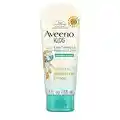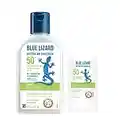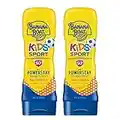Introduction
Children's skin is delicate and susceptible to damage from the sun's ultraviolet (UV) rays. Sun protection is critical not only to prevent painful sunburns in the short term but also to minimize the risk of skin cancer in the future. Here's a comprehensive guide to understanding and ensuring proper sun protection for your kids.
Understanding Sunscreen: Key Components and How They Work
Sunscreen, a crucial tool in our sun protection arsenal, works by absorbing, reflecting, or scattering the sun's rays on the skin. It's a blend of organic and inorganic ingredients that help to shield our skin from the sun's damaging UV rays.
Chemical vs. Physical Sunscreens
Chemical sunscreens contain organic compounds that absorb UV radiation, transforming it into heat that dissipates in the skin. Common chemical sunscreen ingredients include avobenzone and oxybenzone. On the other hand, physical sunscreens, often referred to as mineral sunscreens, use inorganic compounds like zinc oxide or titanium dioxide. These ingredients act like tiny mirrors, reflecting and scattering UV radiation away from the skin.
Understanding SPF
SPF, or Sun Protection Factor, measures a sunscreen's ability to block UVB rays, which cause sunburn and contribute to skin cancer. SPF 15 blocks about 93% of UVB rays, SPF 30 blocks 97%, and SPF 50 blocks 98%. However, no sunscreen can block 100% of UVB rays. For children, dermatologists generally recommend using a sunscreen with an SPF of 30 or higher.
Broad-Spectrum Protection
A sunscreen's SPF rating doesn't tell you anything about protection from UVA rays, which can prematurely age your skin and contribute to skin cancer. To ensure you're getting protection from both UVA and UVB rays, look for sunscreens labeled "broad-spectrum."
Choosing the Right Sunscreen for Children
When selecting a sunscreen for your child, several factors come into play.
Child's Age and Skin Type
Infants under six months should avoid sun exposure as much as possible. For unavoidable circumstances, use a small amount of mineral sunscreen. For older children, consider their skin type. Kids with fair skin, light hair and eyes, freckles, or a family history of skin cancer are at a higher risk and need more protection.
Allergies and Skin Sensitivities
Some children may be allergic to certain sunscreen ingredients. If your child has sensitive skin or a skin condition like eczema, choose a fragrance-free, hypoallergenic, and mineral-based sunscreen.
Activity Level and Water Resistance
If your child will be swimming or sweating, look for a water-resistant sunscreen. Remember, "water-resistant" doesn't mean "waterproof." Reapply sunscreen every two hours and immediately after swimming or heavy sweating.
Correct Application of Sunscreen
Applying sunscreen correctly is just as crucial as selecting the right one.
When and How to Apply Sunscreen
Sunscreen should be applied 15-30 minutes before going outdoors. For lotion sunscreens, a good rule of thumb is to use an ounce (about a shot glass full) to cover the entire body. Don't forget often-overlooked areas like the ears, tops of feet, and the back of the knees.
Reapplication of Sunscreen
Even the best sunscreens must be reapplied every two hours, or more frequently if your child is sweating or swimming.
Beyond Sunscreen: Other Sun Protection Measures
While sunscreen is vital, it's only one part of a comprehensive sun protection strategy. It's crucial to reinforce other sun-safety habits with your children.
Time in the Sun
Try to limit your child's exposureto the sun, especially between 10 a.m. and 4 p.m., when the sun's rays are most potent. If that's not possible, ensure they're adequately protected with sunscreen and other sun-safe practices.
Clothing
Dress your child in sun-protective clothing when possible. Long-sleeved shirts, pants, wide-brimmed hats, and sunglasses can provide excellent protection against the sun's rays. Clothes with a UV Protection Factor (UPF) rating are especially helpful.
Shade
Encourage your child to play in the shade, particularly during peak sun hours. Use umbrellas, sun tents, or other shade-providing items when outdoor shade is not available.
Hydration
Sun exposure can lead to dehydration, especially in children. Ensure your child drinks plenty of fluids when spending time in the sun.
Conclusion
Sun protection for children is not just about preventing uncomfortable sunburns; it's about instilling lifelong habits that can help prevent skin cancer. By understanding how sunscreen works, choosing the right one for your child, applying it correctly, and incorporating other sun-safe habits, we can give our children the protection they need and deserve.
Remember, every day is a sun-safe day. Make sun protection a habit that sticks with your child as they grow, and it will serve them well throughout their life.
FAQs
1. What type of sunscreen is best for children?
Mineral or physical sunscreens that contain zinc oxide or titanium dioxide are often recommended for children due to their sensitive skin. These sunscreens provide broad-spectrum protection and are less likely to cause skin irritation.
2. How often should I apply sunscreen on my child?
Sunscreen should be applied every two hours, or more frequently if your child is swimming or sweating heavily.
3. Do children of all skin tones need sunscreen?
Yes, all children, regardless of skin color, need protection from UV rays. While darker skin has more melanin, which provides some protection, it's not enough to prevent UV damage.
4. Is sunscreen necessary on cloudy days?
Yes, up to 80% of the sun's harmful UV rays can penetrate clouds, so it's important to apply sunscreen even on cloudy days.
5. Besides sunscreen, what else can I do to protect my child from the sun?
In addition to sunscreen, dress your child in sun-protective clothing, encourage play in the shade, and ensure they stay hydrated. Limit sun exposure during peak hours (10 a.m. to 4 p.m.) when the sun's rays are most potent.



